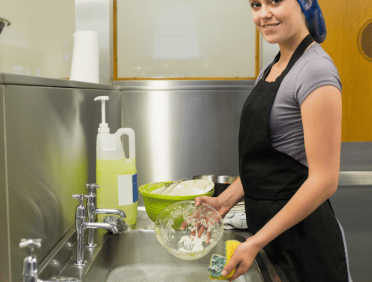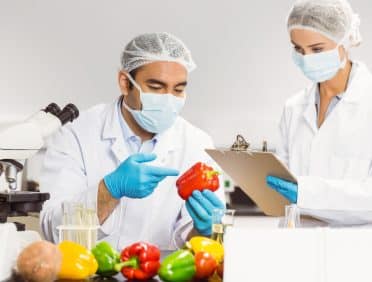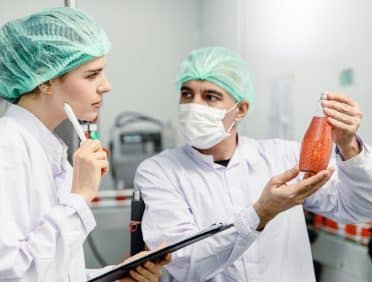Food safety risks and food safety risk assessments are a normal part of everyday operations in the kitchen. Knowing how to understand risk assessments and the risks presented by basic handling, preparing and packaging of food is very important.
What Are Food Safety Risk Assessments?
Food safety risk assessments are all about identifying some of the potential risks that can crop up involving food safety in the workplace. When you handle, prepare, package, and serve food to consumers, you have to do a risk assessment to account for the potential dangers in the workplace.
Things like cross-contamination, food poisoning, bacteria, allergens, and other things like it are all part of a food risk assessment.
How the Risk Analysis Process Works
The way in which the risk analysis process works is by using science and evidence to provide practical advice to businesses and consumers regarding food safety risks.
Essentially, the process works by finding the risks to human health, identifying them, coming up with ways to control these risks, and then communicating this to businesses, consumers, or official authorities as necessary. During the process, solutions will be designed and implemented.
When it comes to food safety, there are few safety organisations to regulate and help to provide advice to businesses regarding food health and safety. It’s important to understand who the main player is, and how they influence the entire process of selling food to consumers.
Who is Involved?
The primary player in food safety organisations is the Food Standards Agency. This is the regulatory body that is officially part of the government, and it helps to regulate and control standards when it comes to trading, selling, and preparing food in the workplace.
The 4 Steps of a Risk Assessment
During a food risk assessment, there are four steps that need to be taken in order to evaluate the risks and hazards connected to specific foods or ingredients.
The first step in the process is hazard identification. This involves examining the food to determine if it or anything in it could be considered harmful. Risk assessors will collect and review scientific information relating to the food, and use that to identify any chemical or biological hazards in the food itself.
The second step of a risk assessment is hazard characterisation. In this part of the process, the risk assessors will look at the data that has been provided and determine whether there is evidence that is strong enough to demonstrate a food or substance has the potential to cause people harm.
They will study the nature of the effects to people’s health, and, if possible, work out a safe level of exposure to introduce guidelines with. A good example of this might be something like alcohol. Scientists discovered that alcohol has a damaging effect on the body when consumed in larger quantities, hence the guidelines we have now.
The third step of the process is assessing exposure. Experts will use the information provided to work out how much of the food affects consumers. They will look at certain population groups, or people with specific diets like vegans, and work out how likely they are to be exposed to the substance and in real life conditions, looking at both duration and dosage. During this part of the process, exposure must be properly evaluated to work out if a hazard presents a genuine risk to people. It’s important to note that the more exposure people have to a substance, the higher the risk factor increases. To carry on the alcohol example, the more that you drink alcohol, the more in danger you become.
The fourth step in the process is risk characterisation. Essentially, this looks at how likely people are to experience exposure to the product which will cause them harm in real life. The end goal of a risk assessment is to calculate a final conclusion about the level of risk based on the data. The level of exposure that would cause harm to somebody is compared to the realistic levels of exposure that somebody would experience in their everyday life. If the exposure level is considered to be higher than that which can cause harm to people, then it may be considered a safety concern for certain people. To continue our example, the exposure level of alcohol would be considered a great risk to children, or people with medical conditions, and this is part of the final assessment.
High Risk Foods
How to Handle High Risk Foods Safely
Handling high-risk food in a safe way is done by avoiding touching the food with your hands. You should use clean utensils to prevent cross contamination. Keep the food stored in the refrigerator until necessary for preparation, and by doing so you reduce the risk of bacteria spreading.
What Are the Hazards?
The general hazards associated with high risk foods include the risk of disease from the bacteria spread from one person to another. Food poisoning is also a common hazard with high-risk food, especially when it is not prepared properly.
How to Control the Risks
It is possible to control the risks of high-risk food by making sure that you practice good hygiene, pay attention to health and safety rules, and store high-risk food in a well sealed, temperature controlled environment, away from other types of food.
Where Should High Risk Food Be Stored?
High-risk food should be stored in temperature controlled environments relevant to the type of food being handled. They should be kept in sealed containers where possible, and if they are meat, stored on the bottom shelf. High risk food should be kept away from other food to prevent the risk of bacteria spreading.
Who is Most at Risk?
People most at risk from these types of foods are people with pre-existing health conditions, the elderly, children, and anybody with a compromised immune system. It’s worth noting that everybody is at risk from high risk food, there is just a handful of groups that are more liable to display noticeable illnesses.
What is Food Poisoning?
Food poisoning is a particularly vicious condition which is the result of many different things involving food. As food poisoning is the worst nightmare of a restaurant, it’s worth understanding what it is.
Food poisoning is an illness which you get from eating food that is contaminated. It’s not a serious condition, but can result in a lawsuit or two from particularly aggrieved victims. Most people get better in a few days without the need for medical treatment. In the majority of cases, food poisoning is the result of bacteria such as salmonella, E. coli, or something like the norovirus.
What Are the Symptoms of Food Poisoning?
The most obvious symptoms of food poisoning include things like nausea and sickness. However, there can be other issues like a high temperature of more than 38°C, a general feeling of being unwell that can include chills and aches, stomach cramps, and diarrhoea.
How to Reduce the Risk of Food Poisoning?
Food poisoning is generally the result of poor hygiene in the workplace, or the cross-contamination of meats and vegetables. Thankfully, there are a number of steps that a business can take to ensure that they are protecting workers and consumers from the effects of food poisoning.
You need to make sure that you clean your hands regularly during food preparation. Wash both your hands and your workstation before, during, and after the preparation of food.
Make sure to separate different types of foods from each other to prevent the risk of cross-contamination. Raw meat, eggs, poultry, and seafood should be kept separate from food that is ready to eat.
You need to ensure that you cook food to the correct internal temperature to kill all of the harmful bacteria that are present in it. This means that you need to follow the instructions for cooking food, and if necessary, invest in a thermometer that you can use to test the middle of food to guarantee it is cooked through.
Finally, make sure that you keep the refrigerator at a temperature of 4° or below to maintain the best possible conditions.
How Can High Risk Foods Cause Food Poisoning?
Unfortunately, it is a very common issue for high-risk food to cause food poisoning. Generally, the reason why this happens is because people are not practising good hygiene in the workplace.
Imagine for a second that you have a high risk food like a piece of meat. If you don’t take the time to properly separate the meat from other food, prepare it in a hygienic way, cook it through, and test the temperature, it’s very easy for the bacteria that is on that meat to spread to other foods or to simply be consumed by your customers.
One of the biggest culprits for food poisoning, as we said, is the poor hygiene practices of staff. Therefore, it’s necessary to have proper training to prevent this.
To download a .pdf of this blog, please click here













